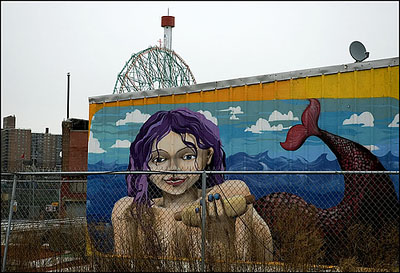
A
Flickr member for several years, I've watched with interest as professional photo users have discovered the site (mostly to troll for freebie visuals). Lately, the press has been asking, What's next? Here are two recent takes: a reprint of an article in the May issue of
Photo District News &
a podcast with some observations on Flickr by British photographer
Martin Parr.
PDN Reprint
Your Friend Flickr?
May 02, 2007
By Daryl Lang
Ryan Brenizer landed a job covering events for Wired.com. Paul Wilcock licensed his concert photos to a few newspapers. Hamad Darwish got an assignment to shoot desktop backgrounds for Microsoft Windows.
What did these photographers do to drum up work? Almost nothing. They uploaded their photos to Flickr and the work found them.
Flickr went online in 2004 as a powerful yet easy-to-use program for storing and sharing personal images. It was acquired by Yahoo! in 2005. Today it leads a double life as a hugely popular site for amateurs to share personal snapshots, and as a growing marketplace for licensing photo rights.With millions of keyworded pictures, the site resembles a big stock library. Photo buyers praise the quality of the photographs and the ease of the Flickr search engine. Professional shooters say the site's forums are a good source of tips and inspiration. Joining the site is free, and with so much traffic it seems like a logical place to set up shop.
But Flickr has done little if anything to welcome professionals. It offers no e-commerce features. It expressly forbids commercial uses of its site. "If we find you selling products, services, or yourself through your photostream, we will terminate your account," its guidelines read. Many of its users happily give their photos away for free.
Transactions that take place off the site are not forbidden, however. Flickr neither encourages nor discourages art buyers from e-mailing photographers to ask for photos, a spokesperson says.Members say such e-mails are on the rise. Flickr's forums bustle with discussions about requests users get for their images, and how much to charge.
Sherri Jackson, a Flickr member who says she shoots for fun and personal expression, noticed more people contacting her in the last few months asking to use her images."I get more requests every week and it's exciting to learn how people wish to use my images," she says. "I like the fact that my work can be out there and available and I really don't have to do anything to market myself."
Another Flickr member to notice this trend is Matthew Blake Powers, a graduate of architecture school who takes photographs as a hobby. "Many times, the e-mails I receive are very casual and get to the point. They simply state who they are, what image they are interested in, and how/why they would like to use it," Powers says.In one case, someone designing the annual report for the Milwaukee Art Museum e-mailed Powers seeking to use one of his photos on the cover. After researching how much to charge, and weighing the fact that he never had anything published before, Powers decided to ask $250. To Powers' disappointment, the museum selected another cover.
Paul Buckley, vice president and executive art director for Penguin, uses Flickr to find photographs, something he mentioned in a story about book publishing in PDN's March issue."I use Flickr as any other stock photo source with a search engine," Buckley says. "That may not be its intended purpose, but it works beautifully, and the site has a smart, powerful search engine." Penguin recently used a Flickr photograph on a book cover.
There is no way to know how much business is conducted through Flickr. One member claims a major ad agency paid him $2,500 to use a Flickr photo as a background in an unaired TV commercial. Darwish's job for Microsoft, shooting landscapes to be included with Windows Vista as desktop wallpaper, was almost certainly a multi-thousand-dollar job.At the other extreme, some blogs and small companies ask to use Flickr photos for free. Some don't even ask."I think a lot of companies are using it as kind of a fishing site for cheap stuff from people without a lot of experience," says Jim Hunter, a stock and assignment photographer and editor of StockPhotographer.info. But even Hunter posts work on Flickr, which he says drives a fair amount of traffic to his professional site. His wife also uses Flickr to share family photos.
Brenizer, who has been shooting events like the New York Comic Con for Wired.com thanks to a Flickr connection, joined the site as a casual member a few years ago. Brenizer credits the site's message boards with teaching him to be a better photographer and jumpstarting his photo career."The passion just totally captured me," he says. "There's that positive reinforcement of all the people on there. . . . Then the people who contacted me started to be clients."A former newspaper editor, Brenizer now works in the publications office of the Columbia University Teachers College, where a large part of his job is shooting photographs. On his own time, he shoots weddings and events, and he spent a week as the photographer-in-residence at a biological research center—all jobs he got through Flickr. "I've never solicited, I've never done any advertising," he says.
Flickr has made some photographers into cult celebrities. David Hobby, a Baltimore Sun staff photographer, publishes a blog about lighting called Strobist. To complement the blog, he started a Flickr group so his readers could share advice and photos.The Strobist group spun out of control and now has more than 7,100 members, who post dozens of messages a day. Hobby doesn't have time to answer all the questions people send him. A lighting seminar he organized sold out weeks in advance. Hobby says he is impressed by how good Flickr photographers are, pointing to the Strobist photo pool. "Almost every one of those pictures has earning potential," he says.Like a lot of Flickr fans, Hobby thinks it's only a matter of time before the service finds a way to monetize this collection of talent. "You don't sit on a big oil well and not drill down eventually," he says.
A Flickr spokesperson would not comment on future plans. For now, Flickr makes money off advertising and by selling upgraded memberships for a small annual fee. It has some direct competitors (including Zoomr, SmugMug and Photobucket) but none with the kind of popularity and goodwill Flickr has achieved.Flickr allows members to set free usage terms by attaching Creative Commons tags to images, so a logical next step might be to let users set prices for certain kinds of usage. Another strategy could be to partner with an existing stock photography site, perhaps one of the royalty-free micropayment sites that also appeal to semi-professional shooters.
Or it could do nothing.
To better understand Flickr's future, it may be helpful to step back and look at how Yahoo! and its investors view the site.In earnings calls and media interviews, no one asks Yahoo! executives how they're going to make money off photographs. Instead, the buzz is all about "Web 2.0," the user-generated, community-focused sites that have attracted huge audiences. Sites like Flickr, MySpace and YouTube are hot because they engage people in a way that traditional media increasingly cannot.Yahoo! recently began requiring Flickr members to use the same ID to log in to Flickr as they use for other services like Yahoo! Mail. As a result, the company can collect more information about users and their online behavior.
To Yahoo!, Flickr's value is not its photography, but rather the desirable audience it attracts for advertisers and marketers. This may explain Flickr's failure to embrace, denounce, or even officially care about the pro community.Somehow, Flickr has created a marketplace for professional photography and made it look like an accident.
Note on Martin Parr Interview
You may find the Parr interview (above link) very slow to load. See transcripted excerpts about Flickr at Michael David Murphy's
2point8 blog.
















